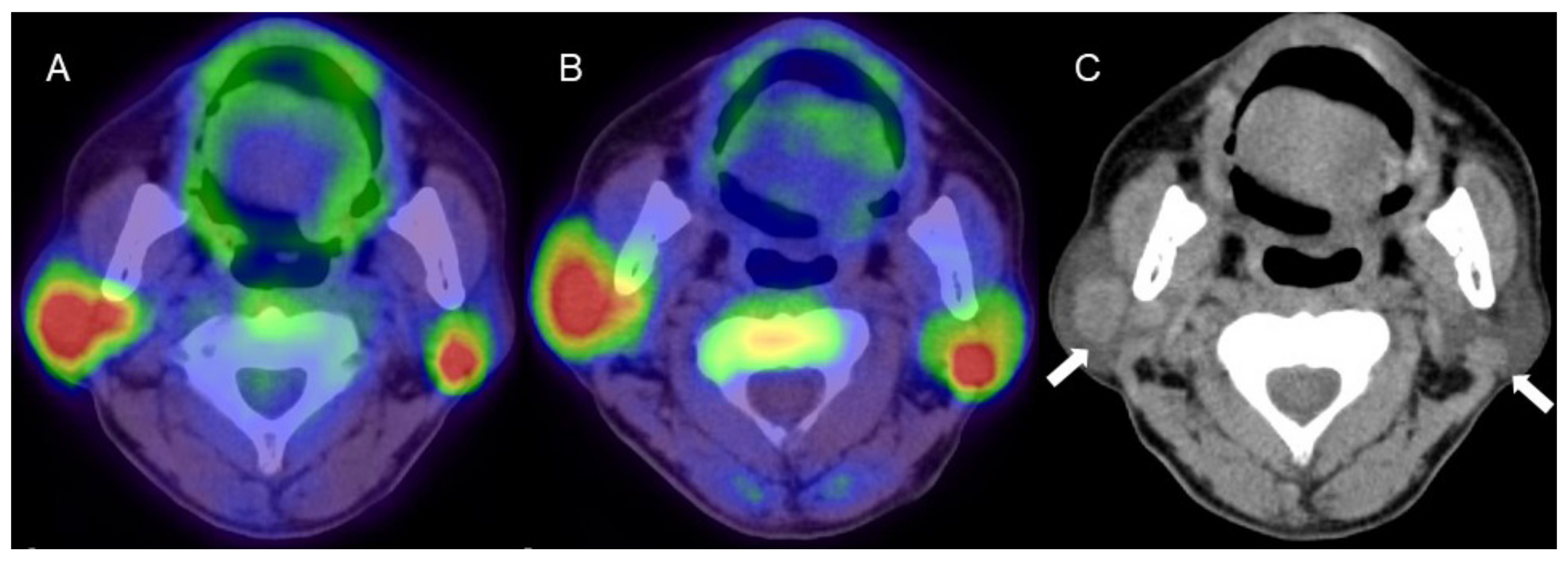Proliferation PET/CT Imaging of Salivary Gland Tumor
Abstract
Author Contributions
Funding
Institutional Review Board Statement
Informed Consent Statement
Data Availability Statement
Conflicts of Interest
Abbreviations
| CXPA: | carcinoma ex-pleomorphic adenoma |
| FDG: | 2-[18F]-fluoro-2-deoxy-d-glucose |
| FLT: | [18F]-fluoro-3′-deoxy-3′-L-fluorothymidine |
| Gd: | gadolinium |
| PA: | Pleomorphic adenoma |
| PET: | positron emission tomography |
| SUV: | standardized uptake value |
| 4DST: | 4′-[methyl-11C]-thiothymidine |
References
- Toyohara, J.; Kumata, K.; Fukushi, K.; Irie, T.; Suzuki, K. Evaluation of 4′-[methyl-14C] thiothymidine for in vivo DNA synthesis imaging. J. Nucl. Med. 2006, 47, 1717–1722. [Google Scholar] [PubMed]
- Minamimoto, R.; Toyohara, J.; Seike, A.; Ito, H.; Endo, H.; Morooka, M.; Nakajima, K.; Mitsumoto, T.; Ito, K.; Okasaki, M.; et al. 4′-[Methyl-11C]-Thiothymidine PET/CT for Proliferation Imaging in Non-Small Cell Lung Cancer. J. Nucl. Med. 2011, 53, 199–206. [Google Scholar] [CrossRef] [PubMed]
- Minamimoto, R.; Nakaigawa, N.; Nagashima, Y.; Toyohara, J.; Ueno, D.; Namura, K.; Nakajima, K.; Yao, M.; Kubota, K. Comparison of 11C-4DST and 18F-FDG PET/CT imaging for advanced renal cell carcinoma: Preliminary study. Abdom. Radiol. 2016, 41, 521–530. [Google Scholar] [CrossRef] [PubMed]
- Ito, K.; Yokoyama, J.; Miyata, Y.; Toyohara, J.; Okasaki, M.; Minamimoto, R.; Morooka, M.; Ishiwata, K.; Kubota, K. Volumetric comparison of positron emission tomography/computed tomography using 4′-[methyl-¹¹C]-thiothymidine with 2-deoxy 2-¹⁸F-fluoro-D-glucose in patients with advanced head and neck squamous cell carcinoma. Nucl. Med. Commun. 2015, 36, 219–225. [Google Scholar] [CrossRef] [PubMed]
- Horiuchi, C.; Tsukuda, M.; Taguchi, T.; Ishiguro, Y.; Okudera, K.; Inoue, T. Correlation between FDG-PET findings and GLUT1 expression in salivary gland pleomorphic adenomas. Ann. Nucl. Med. 2008, 22, 693–698. [Google Scholar] [CrossRef] [PubMed]
- Linecker, A.; Kermer, C.; Sulzbacher, I.; Angelberger, P.; Kletter, K.; Dudczak, R.; Ewers, R.; Becherer, A. Uptake of (18)F-FLT and (18)F-FDG in primary head and neck cancer correlates with survival. Nuklearmedizin 2008, 47, 80–85. [Google Scholar] [CrossRef] [PubMed]
- Faur, A.C.; Sas, I.; Motoc, A.G.; Cornianu, M.; Zamfir, C.L.; Lazăr, D.C.; Folescu, R. Ki-67 and p53 immunostaining assessment of proliferative activity in salivary tumors. Rom. J. Morphol. Embryol. 2015, 56, 1429–1439. [Google Scholar] [PubMed]
- Horii, A.; Yoshida, J.; Sakai, M.; Okamoto, S.; Kubo, T. Flow cytometric analysis of DNA content and Ki-67-positive fractions in the diagnosis of salivary gland tumors. Eur. Arch. Otorhinolaryngol. 1998, 255, 265–268. [Google Scholar] [CrossRef] [PubMed]
- Kuzenko, Y.V.; Romanuk, A.M.; Dyachenko, O.O.; Hudymenko, O. Pathogenesis of Warthin’s tumors. Interv. Med. Appl. Sci. 2016, 8, 41–48. [Google Scholar] [CrossRef] [PubMed]
- Minamimoto, R.; Hotta, M.; Hiroe, M.; Awaya, T.; Nakajima, K.; Okazaki, O.; Yamashita, H.; Kaneko, H.; Hiroi, Y. Proliferation imaging with 11C-4DST PET/CT for the evaluation of cardiac sarcoidosis, compared with FDG-PET/CT given a long fasting preparation protocol. J. Nucl. Cardiol. 2021, 28, 752–755. [Google Scholar] [CrossRef] [PubMed]
- De Souza, L.B.; de Oliveira, L.C.; Nonaka, C.F.W.; Lopes, M.L.D.S.; Pinto, L.P.; Queiroz, L.M.G. Immunoexpression of GLUT-1 and angiogenic index in pleomorphic adenomas, adenoid cystic carcinomas, and mucoepidermoid carcinomas of the salivary glands. Eur. Arch. Otorhinolaryngol. 2017, 274, 2549–2556. [Google Scholar] [CrossRef] [PubMed]
- Alves, F.A.; Perez, D.E.; Almeida, O.P.; Lopes, M.A.; Kowalski, L.P. Pleomorphic adenoma of the submandibular gland: Clinicopathological and immunohistochemical features of 60 cases in Brazil. Arch. Otolaryngol. Head Neck Surg. 2002, 128, 1400–1403. [Google Scholar] [CrossRef] [PubMed]
- Alves, F.A.; Pires, F.R.; De Almeida, O.P.; Lopes, M.A.; Kowalski, L.P. PCNA, ki-67 and p53 expressions in submandibular salivary gland tumours. Int. J. Oral Maxillofac. Surg. 2004, 33, 593–597. [Google Scholar] [CrossRef] [PubMed]
- Hirabayashi, S. Immunohistochemical detection of DNA topoisomerase Type II alpha and ki-67 in adenoid cystic carcinoma and pleomorphic adenoma of the salivary gland. J. Oral Pathol. Med. 1999, 28, 131–136. [Google Scholar] [CrossRef] [PubMed]
- Vargas, P.A.; Cheng, Y.; Barrett, A.W.; Craig, G.T.; Speight, P.M. Expression of mcm-2, ki-67 and geminin in benign and malignant salivary gland tumours. J. Oral Pathol. Med. 2008, 37, 309–318. [Google Scholar] [CrossRef] [PubMed]
- Kaza, S.; Rao, T.J.M.; Mikkilineni, A.; Ratnam, G.V.; Rao, D.R. Ki-67 Index in Salivary Gland Neoplasms. Int. J. Phonosurg. Laryngol. 2016, 6, 1–7. [Google Scholar] [CrossRef]
- Mariano, F.V.; Costa, A.F.; Gondak, R.O.; Martins, A.S.; Del Negro, A.; Tincani, Á.J.; Altemani, A.; de Almeida, O.P.; Kowalski, L.P. Cellular Proliferation Index between Carcinoma Ex-Pleomorphic Adenoma and Pleomorphic Adenoma. Braz. Dent. J. 2015, 26, 416–421. [Google Scholar] [CrossRef] [PubMed]
- Bussari, S.; Ganvir, S.M.; Sarode, M.; Jeergal, P.A.; Deshmukh, A.; Srivastava, H. Immunohistochemical Detection of Proliferative Marker Ki-67 in Benign and Malignant Salivary Gland Tumors. J. Contemp. Dent. Pract. 2018, 19, 375–383. [Google Scholar] [CrossRef] [PubMed]
- Kitayama, T.; Kunimura, T.; Sugiyama, T.; Omatsu, M.; Arima, S.; Mori, T.; Date, H.; Matsuo, K.; Ochiai, Y.; Mori, K.; et al. Immunohistochemical Features of an Atypical Plemorphic Adenoma of the Salivary Gland—Overexpression of Ki-67 and p53. Showa Univ. J. Med. Sci. 2009, 21, 311–317. [Google Scholar] [CrossRef][Green Version]
- Zaghi, S.; Hendizadeh, L.; Hung, T.; Farahvar, S.; Abemayor, E.; Sepahdari, A.R. MRI criteria for the diagnosis of pleomorphic adenoma: A validation study. Am. J. Otolaryngol. 2014, 35, 713–718. [Google Scholar] [CrossRef] [PubMed]



Publisher’s Note: MDPI stays neutral with regard to jurisdictional claims in published maps and institutional affiliations. |
© 2021 by the author. Licensee MDPI, Basel, Switzerland. This article is an open access article distributed under the terms and conditions of the Creative Commons Attribution (CC BY) license (https://creativecommons.org/licenses/by/4.0/).
Share and Cite
Minamimoto, R. Proliferation PET/CT Imaging of Salivary Gland Tumor. Diagnostics 2021, 11, 2065. https://doi.org/10.3390/diagnostics11112065
Minamimoto R. Proliferation PET/CT Imaging of Salivary Gland Tumor. Diagnostics. 2021; 11(11):2065. https://doi.org/10.3390/diagnostics11112065
Chicago/Turabian StyleMinamimoto, Ryogo. 2021. "Proliferation PET/CT Imaging of Salivary Gland Tumor" Diagnostics 11, no. 11: 2065. https://doi.org/10.3390/diagnostics11112065
APA StyleMinamimoto, R. (2021). Proliferation PET/CT Imaging of Salivary Gland Tumor. Diagnostics, 11(11), 2065. https://doi.org/10.3390/diagnostics11112065





